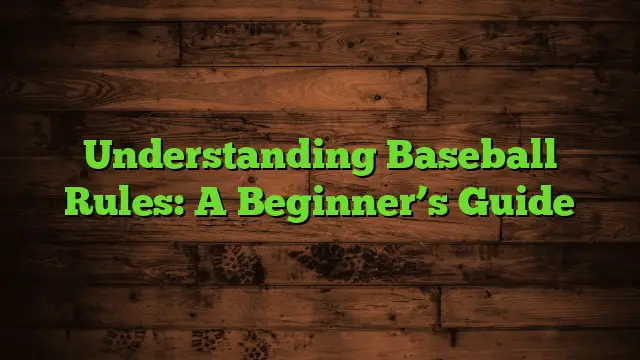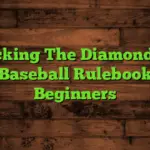Baseball can seem complicated at first glance, a confusing whirlwind of strikes, balls, and runners. But once you understand the fundamentals, the game becomes incredibly engaging and rewarding to watch and play. This comprehensive guide will walk you through everything you need to know to grasp the core rules of baseball, from the basics of the game to more advanced strategies. How to understand baseball rules for beginners is our focus today, so let’s dive in! You’ll learn about the field, the scoring, the different types of pitches, and common strategies. By the end, you’ll be able to confidently follow a game and maybe even start playing yourself.
The baseball field is a diamond-shaped infield, with four bases (first, second, third, and home plate) forming its corners. The distance between bases is 90
feet. The outfield extends beyond the infield, with varying distances depending on the level of play. Understanding the layout is key to following the game.
Innings and Outs: The Game’s Structure
Understanding Innings
A baseball game consists of nine innings. Each inning is divided into two halves, the top (visiting team’s turn at bat) and the bottom (home team’s turn). A team continues its half-inning until three outs are recorded.
What Constitutes an Out?
There are several ways a batter or runner can be called out. These include striking out (three strikes), being thrown out (a fielder catches a batted ball and throws it to a base before a runner reaches it), forcing a runner out (a runner is tagged out while another runner advances), and fielding a batted ball and stepping on a base before the runner reaches it.
The Batter’s Box: Hitting the Ball
At Bats and Strikes
The batter’s goal is to hit the ball pitched by the pitcher. A strike is a pitch that is within the “strike zone” (an area over home plate determined by the umpire). Three strikes result in an out. Balls are pitches outside the strike zone. Four balls result in a walk, where the batter advances to first base.
Types of Hits
A hit occurs when the batter successfully hits the ball into fair territory (within the foul lines) and it’s not caught on the fly. Common types of hits include singles, doubles, triples, and home runs. A home run is a hit that allows the batter to safely circle all the bases and score a run.
Running the Bases: Scoring Runs
Advancing Bases
Once a batter hits the ball, they run towards first base. Successfully reaching first base means the batter is safe and becomes a runner. Runners can advance to other bases by hitting the ball, stealing bases (running while the pitcher is pitching), or advancing on passed balls or wild pitches.
Scoring Runs
A run is scored when a runner successfully touches all four bases and reaches home plate. The team with the most runs at the end of nine innings (or after extra innings if necessary) wins the game.
The Pitcher’s Mound: Delivering the Pitch
The Pitching Motion
The pitcher’s role is to throw the ball to the batter. The pitcher’s motion must be legal; various illegal pitching motions can be called as a balk, sometimes resulting in penalties.
Types of Pitches
There are many types of pitches, each with its unique speed, movement, and trajectory. These include fastballs, curveballs, sliders, changeups, and knuckleballs. Understanding the different pitches helps in understanding the strategic elements of the game.
Fielding the Ball: Defensive Plays
Infielders and Outfielders
The nine players on the field are positioned strategically to field batted balls. Infielders (first baseman, second baseman, shortstop, third baseman) cover the area closer to home plate, while outfielders (left fielder, center fielder, right fielder) cover the area further away.
Defensive Plays
Defensive plays include catching batted balls, throwing the ball to bases to get runners out, and making plays to prevent runners from advancing.
Understanding the Umpires: Making the Calls
The Umpire’s Role
Umpires are the referees of the game. They make calls on balls, strikes, and other aspects of play, ensuring fair play and resolving disputes.
Umpire Signals
Umpires use various hand signals to communicate their calls. These signals indicate strikes, balls, outs, and other game-related actions.
Baseball Strategies: Offensive and Defensive
Offensive Strategies
Offensive strategies focus on scoring runs. These include bunting (lightly tapping the ball to advance runners), stealing bases, and hitting for power (hitting home runs).
Defensive Strategies
Defensive strategies aim to prevent runs. These include strategic positioning of fielders, shifting fielders based on the batter’s tendencies, and using different pitching styles to deceive the batter.
Baseball Terminology: Decoding the Jargon
Common Baseball Terms
Baseball has its own unique vocabulary. Understanding key terms such as “strikeout,” “walk,” “double play,” and “sacrifice fly” helps in comprehending game broadcasts and analysis.
Understanding Statistics
Various statistics are used to analyze players’ performance. These statistics include batting average, earned run average (ERA), and on-base percentage (OBP).
Watching a Baseball Game: Tips for Beginners
Following the Action
Watching a baseball game can be more enjoyable once you understand the basic rules. Pay attention to the pitches, the hits, and the runners’ movements around the bases.
Understanding Commentary
Game commentators often use baseball jargon. Trying to understand these terms enhances the viewing experience.
Advanced Baseball Concepts: Beyond the Basics
Situational Hitting
Understanding the context of each at-bat (runners on base, outs, score) is crucial for appreciating advanced offensive strategies.
Pitching Matchups
Pitching matchups (pitcher versus batter) often determine the outcome of games. Understanding these dynamics reveals the strategic depth of baseball.
The Equipment Used in Baseball
The Bat
The bat is crucial equipment for batters. Its size and weight affect the batter’s power and accuracy.
The Glove
Gloves protect fielders’ hands and help them catch the ball more effectively. Different positions use gloves of varying sizes and designs.
Different Leagues and Levels of Play
Major League Baseball (MLB)
MLB is the highest level of professional baseball in North America. Teams compete in a season-long competition, culminating in the World Series.
Minor League Baseball
Minor leagues serve as a development system for future MLB players. These leagues offer different levels of competition.
Baseball’s History and Culture
The Origins of Baseball
Baseball’s origins are rooted in 19th-century America. The game evolved from earlier bat-and-ball games.
Baseball’s Cultural Impact
Baseball has significantly influenced American culture. The game has become a symbol of national identity.
Frequently Asked Questions
What is the difference between a strike and a ball?
A strike is a pitch within the strike zone that the batter doesn’t hit, while a ball is a pitch outside the strike zone.
What is a home run?
A home run is a hit where the batter successfully hits the ball and runs around all four bases without being put out.
How many innings are in a baseball game?
There are nine innings in a regular baseball game. More innings may be played if the score is tied at the end of nine.
What is a double play?
A double play occurs when the defensive team records two outs on one play, often involving a ground ball hit to an infielder.
What is a stolen base?
A stolen base is when a runner advances to the next base while the pitcher is delivering a pitch.
How many players are on a baseball team?
There are nine players on the field for each team during a game.
Final Thoughts
Understanding the rules of baseball opens up a whole new world of exciting sports entertainment. From the thrill of a close play at the plate to the strategic brilliance of a well-executed double play, baseball offers a captivating blend of athleticism and strategy. By grasping the basic concepts covered in this guide – from understanding the diamond to recognizing the various types of pitches and plays – you’ll be well-equipped to follow and appreciate the game on a deeper level. Whether you’re a casual fan or aspiring to play yourself, knowing the rules empowers you to engage fully with the unique and enduring appeal of baseball. So, grab a glove, head to the field, or settle in for a game – your newfound understanding will elevate your experience.





